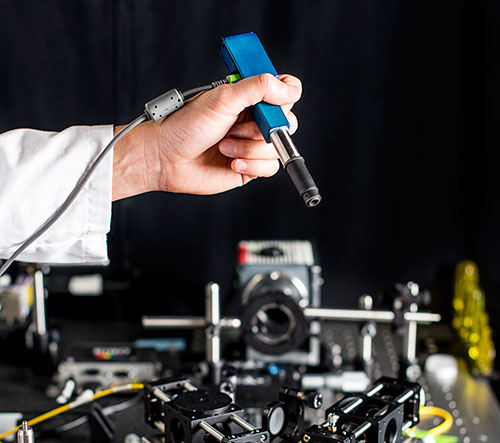New handheld, pen-sized microscope could ID cancer cells in doctor's offices and operating rooms
UW mechanical engineers are developing a miniature microscope that will allow doctors and dentists to distinguish between healthy and cancerous cells in an office setting.
This new technology, which is being advanced in collaboration with Memorial Sloan Kettering Cancer Center, Stanford University and the Barrow Neurological Institute, will also give surgeons the ability to “see” at a cellular level in the operating room and determine where to stop cutting.

Pen-sized microscope under development by UW mechanical engineers
"Surgeons don't have a very good way of knowing when they're done cutting out a tumor," said Jonathan Liu, UW assistant professor of mechanical engineering and one of the principal investigators. "They're using their sense of sight, their sense of touch, pre-operative images of the brain — and oftentimes it's pretty subjective.
"Being able to zoom and see at the cellular level during the surgery would really help them to accurately differentiate between tumor and normal tissues and improve patient outcomes," said Liu.
The handheld microscope, roughly the size of a pen, combines technologies in a novel way to deliver high-quality images at faster speeds than existing devices. Researchers expect to begin testing it as a cancer-screening tool in clinical settings next year.
Family technology rules: What kids expect of parents
A new study from UW human centered design and engineering researchers is among the first to survey kids about technology rules they would set for their parents.
The surveys revealed kids' feelings about fairness and "oversharing," the most effective types of technology rules and families' most common approaches. The technology rules kids wished their parents would follow fell into seven general categories:
- Be present: Children felt there should be no technology at all in certain situations, such as when a child is trying to talk to a parent
- Child autonomy: Parents should allow children to make their own decisions about technology use without interference
- Moderate use: Parents should use technology in moderation and in balance with other activities
- Supervise children: Parents should establish and enforce technology-related rules for children’s own protection
- Not while driving: Parents shouldn’t text while driving or sitting at a traffic light
- No hypocrisy: Parents should practice what they preach, such as staying off the Internet at mealtimes
- No oversharing: Parents shouldn’t share information online about their children without explicit permission.
Invisible connections, significant transmissions: UW engineers achieve Wi-Fi at 10,000 times lower power
The upside of Wi-Fi is that it’s everywhere—invisibly connecting laptops to printers, allowing smartphones to make calls or stream movies without cell service, and letting online gamers battle it out.
The downside is that using Wi-Fi consumes a significant amount of energy, draining the batteries on all those connected devices.
Now, a team of UW computer scientists and engineers has demonstrated that it’s possible to generate Wi-Fi transmissions using 10,000 times less power than conventional methods. This new Passive Wi-Fi system transmits Wi-Fi signals at bit rates of up to 11 megabits per second that can be decoded on any of the billions of devices with Wi-Fi connectivity, but it does so by turning existing signals in the air into power sources for battery-free devices.
In addition to saving battery life on today’s devices, wireless communication that uses almost no power will help enable an “Internet of Things” reality where household devices and wearable sensors can communicate using Wi-Fi without worrying about power.
The lead developers of Passive Wi-Fi technology include Shyam Gollakota, assistant professor in computer science and engineering, and Joshua Smith, an associate professor in computer science & engineering and in electrical engineering. In March, Gollakota was named to CNN Money’s list of top five innovators changing the world. The technology has also been heralded as one of the 10 breakthrough technologies of 2016 by MIT Technology Review and is being commercialized through a spin-off company, Jeeva Wireless.